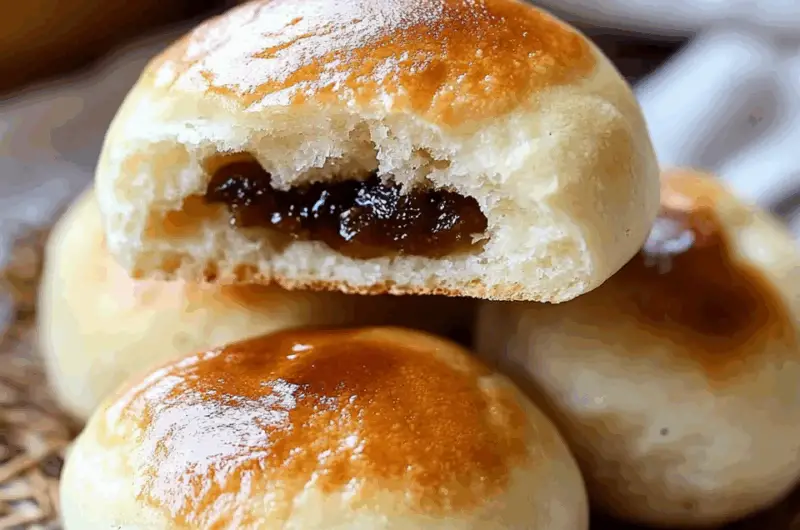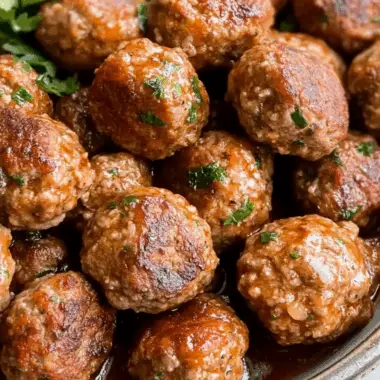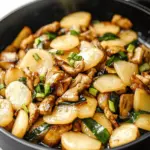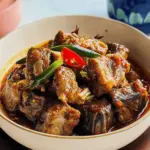Chinese Brown Sugar Bread (Guo Kui) is a delightful sweet bread that originated from the northwestern regions of China. This variation, particularly popular in Chengdu, is a slightly chewy and crispy bread with a sweet brown sugar filling. The bread is simple to make and delivers a comforting treat with a tender yet firm texture, making it perfect as a snack or dessert.
Full Recipe:
Ingredients
-
For the Dough:
-
300g (2 + 1/3 cups) all-purpose flour, more for dusting
-
150g (150ml) water
-
2g (1/2 tsp) salt
-
1 tsp instant yeast
-
Oil for brushing
-
-
For the Filling:
-
16g (2 tbsp) all-purpose flour
-
55g (1/4 cup) powdered brown sugar
-
A tiny pinch of salt
-
Directions
-
Prepare the Filling: Mix brown sugar, flour, and salt in a small bowl. Set aside.
-
Make the Dough: In a stand mixer, combine flour, salt, instant yeast, and water. Mix on low speed for 8-9 minutes until the dough is soft and smooth. Cover with a wet cloth or plastic wrap, and let it rest for 30-45 minutes until the dough has expanded by ⅓ in size.
-
Shape the Dough: Once rested, knead the dough to remove air, then roll it into a long log about 4cm in diameter. Cut the log into 14 equal pieces.
-
Assemble the Bread: Wrap the powdered brown sugar filling into each piece of dough.
-
Cook the Bread: Brush a thin layer of oil in a cast-iron pan. Place each bread piece into the pan, cover with a lid, and cook each side for 6-8 minutes over low heat until golden brown and cooked through.
Nutrients (Per Guo Kui)
-
Calories: 104 kcal
-
Carbohydrates: 21g
-
Protein: 2g
-
Sodium: 70mg
-
Potassium: 31mg
-
Sugar: 3g
-
Calcium: 6mg
-
Iron: 1.1mg
The Origins and Appeal of Guo Kui
Guo Kui has its roots in the diverse culinary traditions of China’s northwestern provinces. The bread is often associated with street food culture, where it is sold as a delicious, quick snack or dessert. Its popularity in Chengdu, a city known for its vibrant food scene, has only contributed to its widespread appreciation throughout the country.
The bread’s appeal lies not only in its taste but also in its simplicity. With just a handful of ingredients, Guo Kui achieves a wonderful balance of flavors and textures. The chewy interior of the dough is complemented by a crispy, golden crust, while the brown sugar filling offers a sweet contrast to the slightly savory dough. Whether enjoyed fresh off the pan or cooled to room temperature, Guo Kui offers a comforting bite that resonates with both children and adults alike.
Key Components: Dough and Filling
The dough used in Guo Kui is a basic yet versatile mixture of flour, water, salt, and instant yeast. This combination results in a dough that’s soft and smooth, perfect for rolling and shaping. The dough is allowed to rest and rise before it is shaped into small pieces, ready to be filled with the sweet brown sugar mixture.
The filling consists of powdered brown sugar, a small amount of flour, and a pinch of salt. This combination creates a sweet, slightly grainy filling that’s perfect for wrapping inside the dough. The brown sugar provides a deep, caramel-like sweetness that perfectly complements the neutral flavor of the dough, creating a satisfying contrast when baked.
Making the Dough: The Foundation of the Bread
To make the dough for Guo Kui, you begin by combining the all-purpose flour, salt, and instant yeast in a stand mixer. The addition of water transforms these dry ingredients into a soft, pliable dough. It’s important to knead the dough for 8-9 minutes on low speed to develop the gluten, which gives the bread its characteristic chewy texture. Once the dough is smooth and elastic, it should be covered with a wet cloth or plastic wrap and allowed to rest for 30-45 minutes. During this resting period, the dough will expand, becoming softer and more manageable for shaping.
The dough’s simplicity and ease of preparation make it an ideal base for the sweet filling. The resting period is crucial, as it allows the dough to rise and develop air pockets that will later help create the chewy texture that defines Guo Kui.
Shaping and Assembling the Bread
Once the dough has rested and expanded, it’s time to shape it into the individual pieces for each Guo Kui. First, knead the dough gently to remove any excess air and ensure an even texture. Next, roll the dough into a long log about 4 cm in diameter, which is then cut into 14 equal pieces. These small portions will each hold a generous amount of brown sugar filling.
To assemble the bread, take one piece of dough and flatten it out with your fingers or a rolling pin. Place a spoonful of the brown sugar filling in the center and carefully wrap the dough around it, sealing the edges to ensure the filling stays inside during cooking. This step is key to getting that perfect bite of sweetness with each piece of Guo Kui.
Cooking the Bread: The Perfect Pan-Frying Method
The traditional method of cooking Guo Kui involves pan-frying the dough to achieve a crispy, golden crust. A thin layer of oil is brushed into a cast-iron pan, and the dough pieces are placed inside. The pan is then covered with a lid to trap heat and ensure that the bread cooks evenly on both sides.
Each side of the bread should be cooked for 6-8 minutes over low heat, allowing the dough to become golden brown and crispy while the filling inside melts into a gooey sweetness. The result is a bread with a slightly crispy exterior and a soft, chewy interior—perfectly balanced with the sweetness of the brown sugar filling.
The pan-frying technique ensures that each piece of Guo Kui retains a satisfying crunch on the outside, while the inside remains tender and filled with warm brown sugar goodness. The careful cooking process helps develop the flavor and texture that make this bread so irresistible.
Serving and Enjoying Guo Kui
Guo Kui can be enjoyed fresh and hot right off the pan, but it is also delicious once cooled to room temperature. The bread’s texture remains tender and slightly chewy, making it perfect for snacking or serving as a dessert after a meal. The sweet brown sugar filling, which is encased in the dough, provides a satisfying contrast to the slightly crispy exterior, creating a balance of flavors and textures that is both comforting and delicious.
In Chinese culture, Guo Kui is often enjoyed as a simple treat with tea or as part of a larger meal. Its versatility makes it suitable for a variety of occasions, from casual family gatherings to more festive celebrations.
Health Benefits and Nutritional Information
While Guo Kui is a deliciously indulgent treat, it’s also relatively simple in terms of nutritional content. Each piece of Guo Kui contains around 104 calories, with 21g of carbohydrates and 2g of protein. The sugar content is modest, with only 3g of sugar per serving. The bread is a good source of energy, providing carbohydrates for fuel, along with a small amount of protein for added sustenance.
The dough itself is made with basic ingredients like all-purpose flour and water, making it a relatively light and simple bread. However, the sweet brown sugar filling adds a small dose of sweetness, making this bread a perfect snack or dessert without being overly indulgent.
Conclusion: A Delightful Snack with a Rich History
Chinese Brown Sugar Bread (Guo Kui) is a delicious and comforting treat that combines the best of both chewy and crispy textures. With its sweet brown sugar filling wrapped in soft, tender dough, it’s no wonder that this bread is beloved in Chengdu and other parts of China. The simplicity of the ingredients and the ease of preparation make it an excellent choice for anyone looking to try their hand at making traditional Chinese pastries at home.
Whether you enjoy it as a snack, a dessert, or a part of a larger meal, Guo Kui offers a delightful experience with each bite. The combination of warm, gooey brown sugar and a perfectly pan-fried crust makes this bread a comforting indulgence that everyone will enjoy. Its rich history and versatility ensure that Guo Kui will remain a cherished treat in Chinese cuisine for generations to come.








